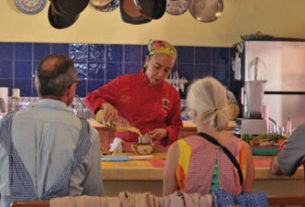This one is an extremely interesting collection of articles about various facets of Mexican life which we gringos probably don’t hear about in the normal course of events. Perhaps if we read Mexican newspapers we’d be more familiar with some of the stories you’ll find here. It’s an odd mixture of very positive descriptions of the country along with some appalling examples of what can happen south of the border.
For instance, in “Lynching in Huejutla” Quinones tells of two salesmen who visit the town of Huejutla, Hidalgo. An innocent piece of kidding between the two men and some young schoolgirls was entirely misread by a few witnesses and – unbelievably – the two men were accused of attempted kidnapping. Within 24 hours the two totally innocent men were lynched by a wild horde of angry townsfolk.
Quinones does a fascinating job of analyzing and explaining all the complex factors that brought about this whole bizarre episode, including an extensive coverup by authorities once it became clear that a terrible injustice had been carried out. The explanation is complex, involving the PRI, corrupt politicians and local attitudes. I couldn’t possibly do justice to the story in a few words. Read it for yourself.
In “Telenovela” the author tells us that we norteamericanos don’t know it but Mexican telenovelas (tv serials) have swept the world with their teary melodramas of romance, passion and evil, betrayal and lies and happy endings. Televisa, Mexico’s entertainment conglomorate and the world’s largest telenovela producer, has sold them to all of Latin America as well as 125 other countries. China has aired 22 Mexican telenovelas. “Den of Wolves” was a huge hit in Australia.
It would be interesting to see if we norteamericanos could name even one of these shows. Yet, by 1996, Televisa could claim that its telenovelas were Mexico’s largest export, ahead of car parts and Corona beer.
In the same vein, he tells the amazing story of Chalino Sanchez (the guy on the cover), a pop singer whose albums sell in the millions. Yet who in the U.S. or Canada has ever heard of him?
Strangely enough, one of the factors that brought about the popularity of the telenovela was the predominance of the PRI, Mexico’s ruling political party – for so many years Mexico’s only party. According to one spokesman: “Mexico is a country with a large class of people who are economically screwed. TV’s responsibility is to bring these people entertainment and distract them from their sad reality and difficult future. Thus, when telenovelas were being filmed, agents of the PRI Interior Ministry were there to ensure that the party line was maintained and that what was portrayed was a Mexico that did not exist. Today the telenovelas are more realistic and just as popular, not only in Mexico but internationally, too. The defeat of the PRI at the polls as well as the creation of a new and competing tv network, Television Azteca, were but two of the factors that brought about a change.
One interesting aspect of Quinones’ view of modern Mexico is that it is changing very rapidly. So rapidly, in fact, that he has included an appendix in his book where he takes many of the chapters he has written and adds an update outlining further changes that have taken place since the initial writing. The biggest change of all, of course, was the defeat of the reigning PRI on Sunday, July 2, 2000. The PRI, formed in 1929, was the world’s oldest one party regime. It was also the first peaceful change of regime in Mexico’s history. Quinones devotes quite a few pages to analyzing this event and its repercussions.
However, I shouldn’t give the impression that “True Tales” is a purely critical or negative account of what goes on here. There are some very laudible accounts of Mexican goings-on which he describes, too.
In “San Quintin” he tells the story of Indian migrant farm workers who left their homes in Oaxaca and moved to the Baja and who are now carving a whole new future for themselves as suppliers of produce to California. At the same time, however, their youngsters are turning their backs on tribal customs as they adjust to the modern world.
Another business success story is “The Popsicle Kings of Tocumbo”. This one describes how a family in that town, about 50 years ago, began an ice cream business. It had very humble beginnings. However, through smart business practices – like diligent quality control, keeping loans to a minimum and paying them off quickly and by carrying out good employment practices, the family still runs the business and has, at last count, over 400 outlets in Mexico. This one could almost be one of those business cases from the Harvard Business School.
The variety in these pages is quite mind-boggling. In “The Jotos of La Fogata” we are given a look at the gay life in macho Mexico. “Leaving Nueva Jerusalén” gives us a rather scary look at a strict theocratic community run by religious fanatics in Michoacán. And in “The Dead Women of Juárez” we get a look at the world of the maquiladoras, those border towns where foreign companies like Ford, General Motors, Hughes, Phillips, RCA, Sony and Toshiba, et al, have built factories and attracted thousands of workers from the interior of Mexico, most of them women. In one community, for example, the population tripled in a couple of decades. But, to explain the title, there were also a frightening number of murders and crimes against women.
There’s yet more but there just isn’t space to do justice to the sheer variety presented here.
In my humble O: Sam Quinones writes for U.S. publications and has covered Mexico since 1994. He really lives up to the promise in his title of giving us “Another Mexico”. Get yourself a copy.
True Tales From Another Mexico
The Lynch Mob, the Popsicle Kings, Chalino and the Bronx
By Sam Quinones
University of New Mexico Press. Paperback. 2001
Available from Amazon Books: Paperback



